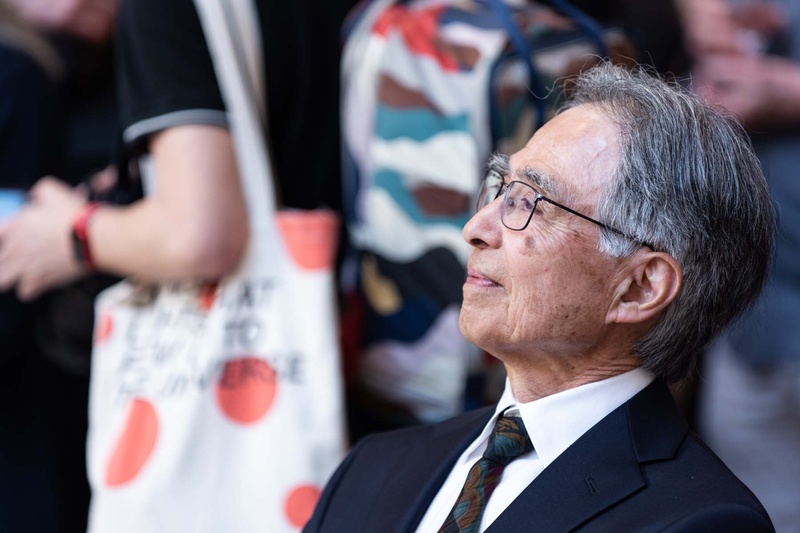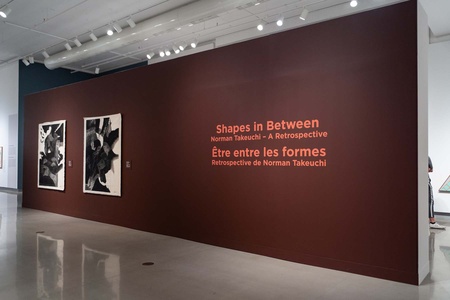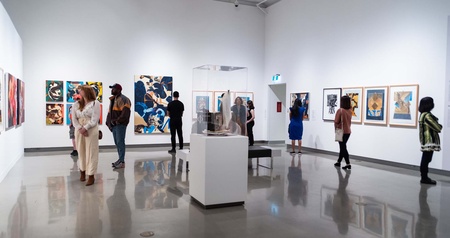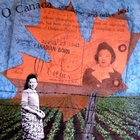“Trying to figure out what it means to be Japanese Canadian is messy work. To sum it up: to me, being JC means feeling conflicted. After all these years of being who I am, I still seem to have to convince myself that I’m Canadian. I’m very aware that no matter where I go, whether it’s to restaurants, art galleries, or the curling rink, I look different from everyone around me.
“The prevalence of racism and the reflections in the mirror reminds me that I’m not white and therefore am questionable. Luckily, there are many fine people, and I know many, who are decent and accepting. But why do I even have to say this?
“In truth, I don’t think I really know what it means to be Japanese Canadian. Life goes on with all its ups and downs and in the end, being JC is being Canadian.”
— Norman Kiyomitsu Takeuchi from an interview with Bryce Kanbara (2023)
The artistic output of newly appointed member of the Order of Canada, Norman Takeuchi (1937-), over the past few years has been astounding. He joins the likes of other Japanese Canadians, like scientist Dr. David Suzuki (1976); osteopathic physician, Dr. Masajiro Miyazaki (1977); teacher/artist, Roy Kiyooka (1978); former editor of the New Canadian newspaper and federal bureaucrat, Tom Shoyama (1978); Vancouver Japanese Language school principal, Tsutae Sato (1978); educator, Hide Shimizu (1982); architect, Raymond Moriyama (1985); writer/poet, Joy Kogawa (1986), among others, Canada’s second highest state honour for merit.
Never mind that he’s been producing art in different forms for more than 60 years. From his inauspicious beginning as an Enemy Alien, being expelled from coastal BC along with 22,000 other Japanese Canadians, going to Vancouver School of Art, graduating in 1962 and having an illustrious career as a graphic designer and fine artist based in Ottawa since 1963. He went to London, England in 1962 with the help of a Leon and Thea Koerner Grant. He returned to London in 1967 with a Canada Council grant with new wife Marion.
“I had produced enough work for a show but this time, no luck. We packed up all the canvases and returned to Ottawa where I was able to show my work.”
In the subsequent decades, Norman has worked as a graphic artist in a number of capacities.
I was first introduced to Norman with his work, “Interior Revisited,” that was part of the Royal Ontario Museum exhibition in 2019. From then it was a whirlwind succession of Equal Time (2020); Scrolling (2022); Long Division (2022); and, now, Shapes in Between: Norman Takeuchi — A Retrospective which runs until August 27, 2023, at the Ottawa Art Gallery.
Remarking about his Shapes In Between, he says, “I can only say the exhibition has exceeded all my expectations! Thanks to everyone involved, not only is my work beautifully and thoughtfully displayed but it is also presented in context to the Japanese Canadian experience. For this, I am indebted to Bryce Kanbara (Hamilton) and Sachiko Okuda (Ottawa). As for how it was curated, I cannot say enough about the curator, Catherine Sinclair! The exhibition is really her vision and she has guided all of us through this project.”

His passion for art began at a very young age. “I never lost that interest and because I seem to have an obsessive nature which compels me to keep trying to do better. Self-discovery might have something to do with it too.”
Deputy Director, Chief Curator at the Ottawa Art Gallery, Catherine Sinclair, says that Norman has worked as an artist in the Ottawa region since 1963, and so this Retrospective exhibition shows over 6 decades of his work.
“He is an important Ottawa artist, and the mandate of the Ottawa Art Gallery is to highlight the work of local artists, in order to bring them into the national art conversation,” she explains. “That is why it is key for us to mount significant exhibitions like this of artists like Norman who have been contributing to the arts of the region for years. We will also produce a substantial exhibition catalogue* of his life and work, that will be launched July 27, and available for sale.” *The catalogue is available for pre-sale.
“Norman was part of a group of key artists that came to the City of Ottawa, and stayed, in the 1960s. They were a small, but strong group of painters and sculptors that created significant modernist art, and really began to put Ottawa on the map as a City with artists as important as other centres in Canada like Montreal, Toronto and Vancouver. They were also activists, and worked to get their artwork noticed by the National Gallery of Canada, and to eventually establish a municipal gallery for Ottawa: the Ottawa Art Gallery. Norman was part of all of this, and it was high time that we create the story of his life and art for the public to see all in one place.”
Norman recalls: “I came to Ottawa in 1963 looking for a job. I was getting ready to return to Canada from my one-year stay in London England and I heard from my former employer in Vancouver that there were job openings in Ottawa for designers to work on the Canadian Pavilion for Expo 67 so I stopped off in Ottawa and got a job with the Canadian Government Exhibition Commission to work on the Canadian Pavilion. I stayed because Marion and I (we got married in 1966) made a life for ourselves here.”
The process of putting the exhibition together began more than two years ago, explains Sinclair.
“They (Norman and Marion) have kept an immaculate archive and inventory of his work over the years, and they were key to the process of sorting through it all. When you organize a Retrospective, you have to literally view everything, and be patient and see what jumps out as a starting point for how to approach the story. Norman and Marion knew the work best, and they were able to help me with this initial navigation through all that was available to see.
“I took away over 300 images, and my intern and I went over it all and brainstormed how to approach it. I brought some choices and suggestions back to Norman and Marion, and we discussed my choices together, and they made many suggestions. It was truly a collaborative process.”
When asked to reflect on different aspects of his ‘artist self,’ Norman says: “As for being a graphic artist, I was interested in graphic design from my art school days and that interest has stayed with me. I still appreciate a beautifully designed piece of typography or package and view them as works of art.
“As a fine artist, even when I was working as a graphic designer, fine art was where I got my ideas when trying to solve design problems. I guess the reverse is true as well. People have said to me that they can see design influences in my paintings even though I try my best to keep the two separate.
“As for my Japanese Canadian artist self, in my earlier years when I saw myself as a Canadian painter and making no references to my Japanese heritage, I also tried my best to divorce myself from my design background. I felt they were two completely different disciplines and should not be mixed. Then, when I became a Japanese Canadian artist incorporating Japanese images into my abstract work, it’s possible my design training started to creep in because the images in the woodblock prints are very stylized designs.
“As for my retirement from my design career, the transition from designer to full-time artist was painless, mainly because I followed the advice of an older artist, Tom Wood, who advised me to start painting and drawing before I left the design office. He told me that if I waited until I retired, I would find myself standing in front of a blank canvas and not knowing where to start. Although I had been painting and drawing for many years, I took his advice and maybe two years before retirement, I put even more energy into producing art. When that day came, I simply continued on in the studio. I will always be grateful for Tom’s advice.
“These days, I think of myself as a senior artist who has put in his time.”
Like other artists of his generations, Aiko Suzuki (1937-2005), Shizuye Takashima (1930-2005), and Lillian Michiko Yano (1945-), Norman’s discovery of his Japanese Canadian self, that epiphany, that lightning bolt out of the blue sky, occurred in 1995 at the Museum of Civilization (now Canadian Museum of History) where an exhibition Homage to Nature: Landscape Kimonos by Itchiku Kubota was shown.
“This show of incredibly beautiful kimonos created by Japanese artist Kubota had quite an impact on me in that these exquisite pieces were created by a Japanese person. The image I had of myself up to this point was of someone who was uncomfortable being of Japanese descent and saw myself as a CANADIAN artist, not a JC artist.”
“It took a few years for the Kubota experience to actually influence my work. It was only when I felt a need to come to terms with being Japanese that I decided I would deal with this through my art. That’s when I remembered Kubota’s kimonos and decided to use the kimono shape as the underpinning, so to speak, of my work.”
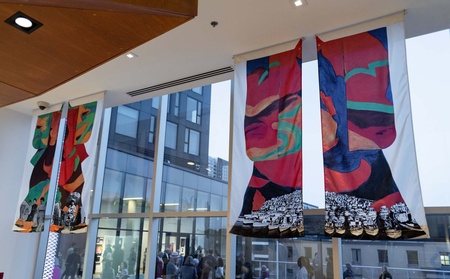
© 2023 Norm Ibuki


